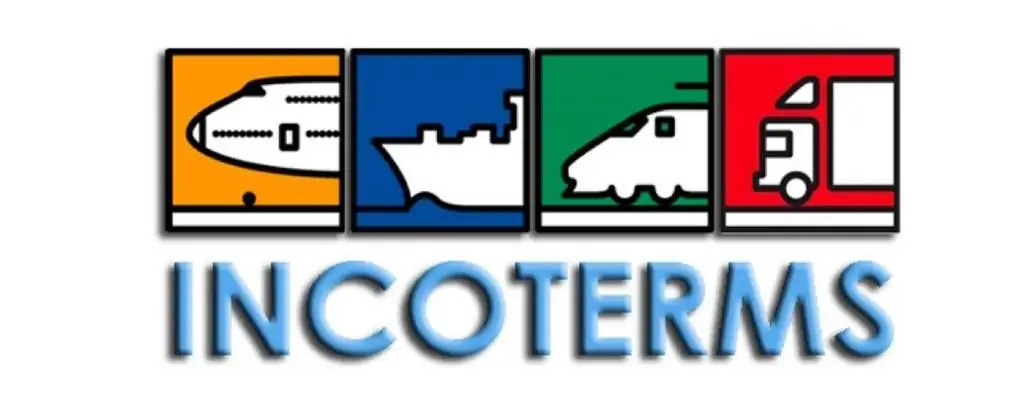2026 Author: Howard Calhoun | [email protected]. Last modified: 2025-06-01 07:12:56
Each entrepreneur, concluding an international commercial agreement, has come across the rules of Incoterms, 2010 (this is the latest edition), which regulate the payment of transport costs, the transfer of risks from the seller to the buyer and the actual transfer of goods. In this article, we will give a brief description of each term, define the features and consider in detail the distribution of responsibilities in the case of delivery on CIF terms.

Delivery terms
Incoterms Rules, 2010 contain four groups of terms:
- E - point of transfer of goods - the warehouse of the manufacturer / seller. Loading is carried out by the buyer. There is only one EXW term in this group.
- F - the buyer pays for the carrier's services, and the seller delivers the goods to the carrier's terminal.
- C - the seller pays for the services of the main carrier. This group includes the conditions we are consideringdeliveries CIF.
- D - transfer of goods in the territory of the buyer. Shipping by seller.
The rules of Incoterms, 2010 contain eleven terms on the terms of delivery, seven of which apply to any transport, and four - only to sea.
A quick look at all the terms:

-
EXW (ex works) - ex-warehouse. This is the most favorite term of exporters, because all responsibility for transportation from the manufacturer's warehouse and for passing through export formalities lies with the buyer.
- FCA (free carrier) - free carrier. The buyer hires a carrier that has terminals in the country of departure. The seller's task is to arrange the export and deliver the goods to the specified terminal.
- CPT (carriage pad to) - delivery paid to such and such point. This term imposes payment of freight to the point of arrival on the seller. After that, the buyer picks up the goods from the point of arrival and performs customs clearance. Under these conditions, the buyer covers the insurance of the goods.
- CIP (carriage and insurance paid to….) - shipping and insurance paid to. A term similar to the terms of the CPT, but with the difference that the insurance is paid by the seller.
-
DAT (delivered at terminal) - delivery to the terminal. You can confuse the terms DAT and CPT. The essential difference is that under the terms of DAT, the seller delivers the goods at his own expense, bears the cost of insurance, to the customs post of the country of destination. Further responsibility passesto the buyer.
- DAP (delivered at place) - delivery to the destination, according to the contract. Group D means the responsibility and risks of the seller to the specified place. Customs duties and taxes are the responsibility of the buyer.
- DDP (delivery duty paid) - shipping and taxes paid. This is the most favorite term of buyers, because under these conditions the seller is responsible for the entire delivery process from his warehouse to the customer's warehouse. In this case, the buyer does not bear any transport or customs costs.
- FAS (free alongside ship). This term, like all subsequent ones, refers only to maritime transport. The cargo is delivered to the port of loading of the buyer, who is responsible for reloading and further transportation.
- FOB (free on board). The seller not only delivers to the buyer's sea transport, but also reloads.
-
CFR (cost and freight). The seller pays for shipping to the specified point. Buyer pays insurance and reloading costs.
- CIF (cost, insurance and freight). These conditions are similar to the previous ones. The main difference between CIF and CFR terms is that insurance is added to the seller's costs (in addition to shipping).

What does CIF mean: transcript
CIF terms of Incoterms, 2010 refer to group C. This means that the goods are delivered at the expense of the seller. This term applies only to transportation by sea. From English, the term cost,insurance and freight translates as "cost, insurance and delivery."
Delivery of goods (according to CIF)

In terms of delivery CIF Incoterms, 2010, it is assumed that the seller delivers the goods to the specified port of the buyer at his own expense. In this case, he chooses the carrier himself. The seller will be charged the cost of loading, export clearance, insurance and delivery of goods.
Responsibility of the parties
In order to understand the CIF term in detail and understand the intricacies of a CIF contract, you need to have clear answers to the following questions:
- Which counterparty is responsible for the delivery of the goods?
- Which counterparty is responsible for customs procedures both in the country of departure and destination?
- Where does the seller's obligation to deliver goods end?
- When does the responsibility for a product pass from the manufacturer-seller to the purchasing party?
- How long does it take the seller to deliver the goods to the buyer?
Seller's responsibility subject to CIF
The seller finds a carrier and concludes a contract for the supply of goods by sea. Shipping costs to be negotiated between seller and carrier.
The seller arranges the cargo for export: pays all export payments and delivers the cargo to the port of departure. He also pays all costs associated with loading and transshipment of the goods, draws up an insurance policy for the goods and pays the costs of insuring the goods for the period of delivery.
Responsibility for the goods passes from the seller to the carrier at the port of departure.

Buyer's responsibility subject to CIF
The buyer provides all the necessary documentation for the import of goods into the country of destination, arranges unloading of goods at the point of arrival, is responsible for customs clearance of goods and payment of fees and taxes for imports in the country of destination.
Also, after inspecting the cargo, he signs the accompanying documents indicating the fulfillment of obligations by the seller.
In addition, the buyer organizes the delivery of the goods to their warehouses and pays for the products, in accordance with the terms of the commercial contract.

Transfer of responsibility for the goods from the manufacturer to the buyer
A clear distinction must be made between the transfer of ownership and the transfer of responsibility for the goods.
The temporary point of transfer of ownership is negotiated between counterparties in a foreign trade contract. The goods can become the property of the buyer both at the time of loading the goods on the ship, and upon receipt of the goods at the port of arrival in the case of a letter of credit. At what point the goods will become the property of the buyer depends on the contractual relationship of the partners and the terms of payment.
Under CIF conditions, responsibility for the cargo, as well as its integrity and completeness, passes from the seller to the carrier after the goods are loaded onto the vessel. For this, a standard insurance policy is issued (100% of the cost of the cargo plus 10%)for the entire load. If desired, the buyer has the right to increase the sum insured and insure additional risks, but at his own expense.
What is included in the price of goods on CIF terms
The cost of the goods specified in the foreign trade agreement, which is supplied on CIF terms, includes the following costs:
- Packaging the goods and applying appropriate markings.
- On loading and delivery of goods to the point of departure.
- According to customs clearance in the country of export.
- On loading the goods onto the ship.
- On delivery to the point of arrival.
- Freight insurance.
Legal features of the contract on CIF terms
The terms of delivery are prescribed in the paragraph of the same name with the obligatory indication of the latest version of Incoterms (for example, Incoterms, 2010).
Also in this paragraph, you must specify the "Port of destination" and "Point in the port of destination".
In addition to the obligations and rights of counterparties, along with the terms of payment, the moment of transfer of ownership is clearly indicated.
CIF conditions assume that at the specified time the buyer will organize prompt unloading from the vessel. Based on the agreement between the seller and the buyer, landed is added to the CIF term. In this case, the cargo is not only delivered to a certain port, but also unloaded.
The contract necessarily states that the beneficiary of the insurance policy is the buyer, so that in case of damage to the goods, he can apply to the insurance company on his own.
Features of declarationgoods on CIF terms
The customs value of the goods under the first main method is the sum of the cost of the goods themselves, the costs of its delivery, insurance, loading and other costs payable or paid by the buyer.

What features of determining the customs value can be distinguished, considering the delivery on the terms of CIF Incoterms, 2010? As you know, under CIF conditions, the cost of goods already includes the costs of delivery and cargo insurance. Customs value, fees and taxes will be calculated based on the invoiced value of the item.
But the customs value should not include costs incurred in the territory of the Customs Union, that is, transportation and insurance costs from the point of arrival in the territory of the Customs Union to the actual destination.
Therefore, when declaring goods, expenses from the point of arrival to the point of destination are deducted from the invoice value (provided that there is documentary evidence from the carrier).
Recommended:
DAP - terms of delivery. Decoding, features, distribution of responsibilities

Incoterms are a series of pre-defined commercial rules published by the International Chamber of Commerce (ICC) relating to international commercial law. They are applied at the conclusion of foreign economic transactions. DAP conditions - this is a situation where the seller hires transport, carries out customs clearance of the goods and delivers it to the place agreed by the parties to the transaction. Unloading, customs clearance and other procedures are the responsibility of the buyer
Electricity distribution: substations, necessary equipment, distribution conditions, application, accounting and control rules

Everyone knows that electrical energy is supplied to the place of its consumption from a direct source. However, such sources can be located at a great distance from the consumer. Because of this, the distribution of electricity and its delivery is a rather complicated process
Faberlic marketing plan: description of the company, features of product distribution

"Faberlik" is a well-known Russian company offering consumers a wide range of different products. Products are distributed by sales consultants, and you can choose the products you are interested in in the official catalog or on the website. Almost anyone can join the Faberlic team. However, in order to succeed, it is necessary to strictly follow the marketing plan of the company
Responsibilities and functional responsibilities of an accountant for primary documentation

This profession is considered very common these days. There are several types of accountants, and one of them is a specialist in primary documentation. It is about him that will be discussed further
Unaddressed mailbox distribution of leaflets and advertisements: features and recommendations

Unaddressed mailbox distribution of booklets, flyers, leaflets and other printed materials is a safe and fairly effective form of advertising. Usually it is used by small and medium-sized commercial organizations, individual entrepreneurs. What is attractive about distributing leaflets in mailboxes? Why do businessmen choose this type of advertising?

